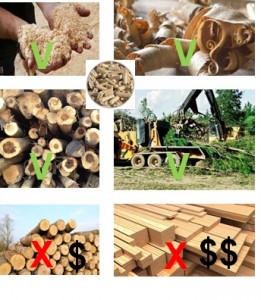The biomass used are wood pellets and which are sustainably sourced.
The wood pellets are made from remains and left-overs:
– Branches and tops of trees.
– “Thinnings“. To give growing trees more space to grow, you periodically remove young trees in between.
– Trees not good enough for timber. E.g. crooked trees, sick trees.
– Saw residues and dust (from saw mills near the forests which saw the trees into timber).
Wood pellets are not made from whole trees. Forest owners would also never allow this. They would make more money from selling the trees as timber (e.g. boards, planks).
Wood pellets are sustainable:
– The wood remains come only from everlasting production-forests, not from rain forests or deforestation.
– Production forests are strongly CO2 negative because it rejuvenates the forest. Areas full of young trees consume much more CO2 than areas with old trees which hardly grow anymore.
– The CO2 footprint of transporting wood across the ocean is limited. It is limited versus the CO2 savings from using wood. It is limited because moving a ship on water does not consume much energy.
Sourcing would only be from suppliers which have full certification and can comply to the very strict Dutch regulations on biomass. These Dutch regulations are the strictest regulations in the world.
